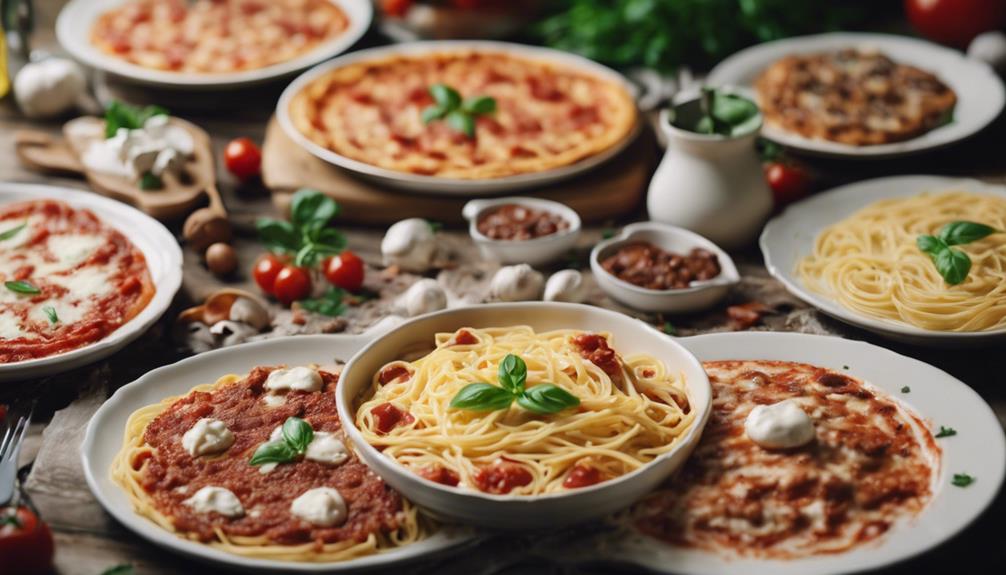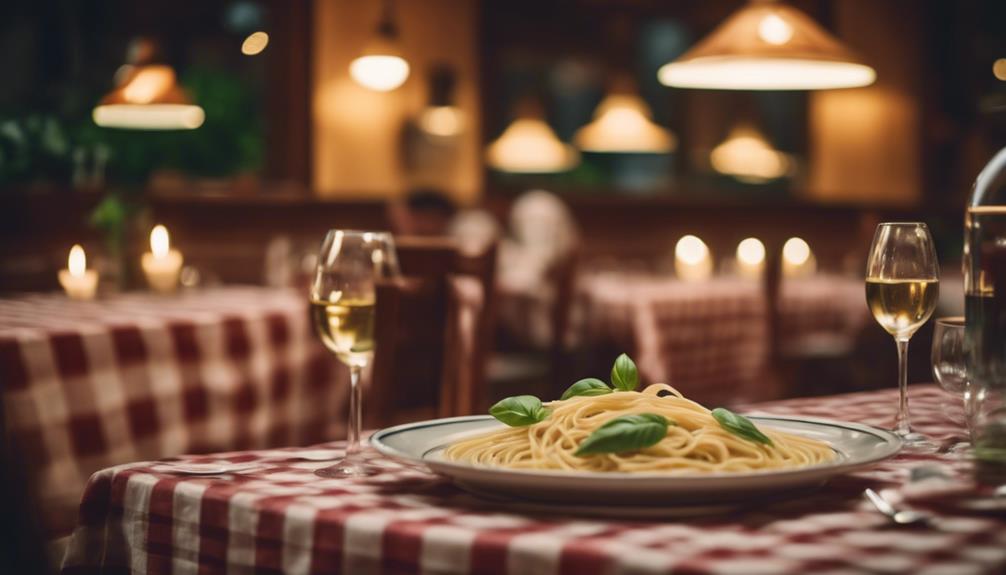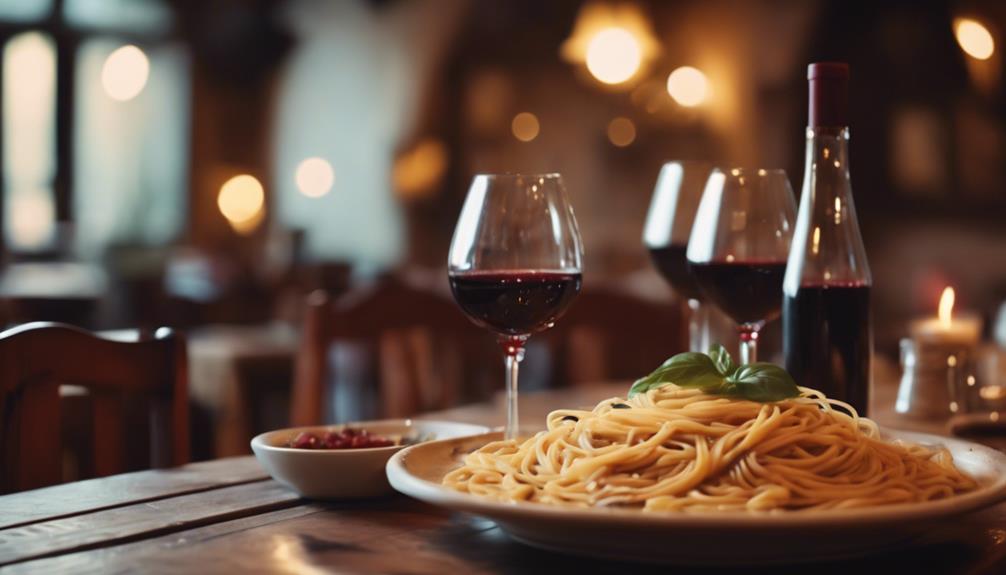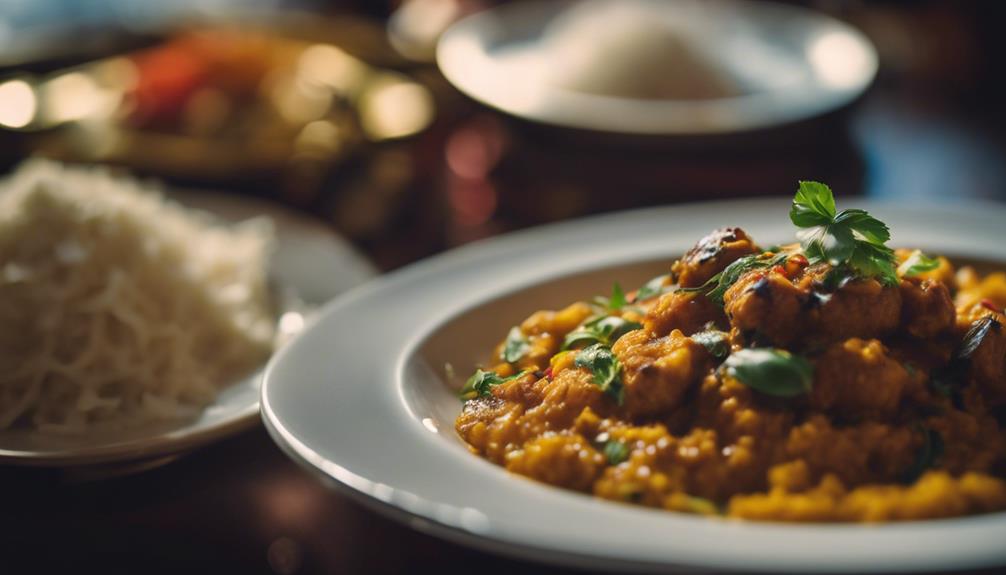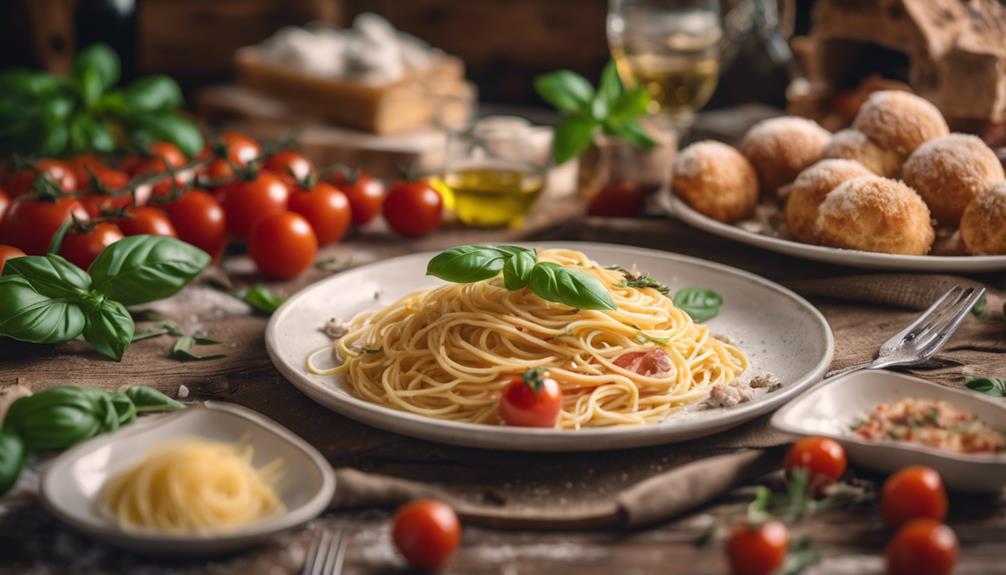Italian cuisine offers a delightful culinary experience that you won’t want to miss! From delicious pizzas cooked in wood-fired ovens to tasty pasta dishes like Bolognese and Carbonara sauces, Italy has something for everyone. Creamy risottos with saffron and mushroom, succulent meat dishes, and seafood specialties will tantalize your taste buds. And let’s not forget about the variety of Italian cheeses and irresistible gelato flavors such as pistachio and hazelnut! These are just a few examples of Italy’s amazing gastronomic offerings. Prepare yourself for a flavorful journey that will transport you to the heart of Italian cuisine!
Key Takeaways
- Traditional Italian dishes include pizza, pasta, risotto, meat specialties, and seafood delicacies.
- Italian cuisine showcases regional specialties and diverse flavors.
- Ingredients like tomatoes, basil, Parmigiano Reggiano, and olive oil are staples.
- Gelato is a popular Italian dessert known for its creamy texture and various flavors.
- Italian cheeses like Mozzarella and Parmigiano Reggiano are essential in many traditional dishes.
Traditional Italian Pizza
Italian cuisine enthusiasts worldwide cherish Traditional Italian Pizza for its rich history and authentic flavors. Originating in Naples, Italian pizza is a staple in the world of Italian food, renowned for its simplicity and quality ingredients.
The Margherita pizza, with its classic combination of tomato sauce, mozzarella cheese, and fresh basil, remains a favorite among pizza lovers for its vibrant flavors.
One of the secrets behind the delectable taste of Italian pizza is its method of cooking in wood-fired ovens. These traditional ovens not only impart a unique smoky flavor to the pizza but also guarantee a crispy crust that's characteristic of Neapolitan pizza.
Although pizza has been adapted in various countries, the traditional Neapolitan pizza continues to hold a special place in Italian food culture. Its popularity has soared worldwide, making it a symbol of Italian cuisine that's loved for its authenticity and mouthwatering taste.
Flavorful Pasta Varieties
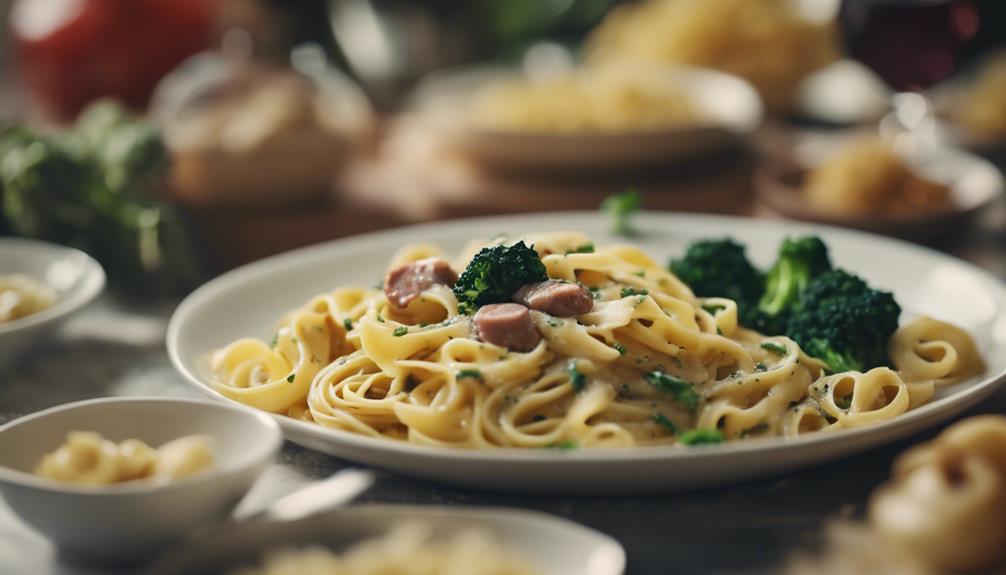
So, you're ready to explore the world of flavorful pasta varieties in Italian cuisine.
From classic pasta types like spaghetti and fettuccine to regional specialties that showcase the diverse culinary traditions of Italy, there's a pasta dish for every palate.
And let's not forget the popular pasta sauces that elevate these dishes to a whole new level of deliciousness!
Classic Pasta Types
When exploring flavorful pasta varieties, you'll encounter a range of classic pasta types that are beloved in Italian cuisine. From the iconic spaghetti to the delightful gnocchi, each pasta type brings its own unique taste and texture to traditional dishes. Check out the table below to learn more about these classic pasta types:
| Pasta Type | Description | Popular Dishes |
|---|---|---|
| Spaghetti | Long, thin pasta often paired with tomato-based sauces | Spaghetti Amatriciana |
| Gnocchi | Small potato dough rounds enjoyed with various sauces | Gnocchi with Pesto Sauce |
| Tortelli | Stuffed pasta parcels filled with delicious fillings | Tortelli di Zucca |
| Ravioli | Stuffed pasta pockets typically served with butter or tomato sauce | Ravioli Ricotta e Spinaci |
| Fettuccine | Flat, thick pasta noodles perfect for creamy or meaty sauces | Fettuccine Alfredo |
| Penne | Short, tube-shaped pasta versatile in various dishes | Penne all'Arrabbiata |
These classic pasta types form the foundation of countless Italian culinary creations, offering a delightful array of flavors and textures to enjoy.
Regional Pasta Specialties
Discovering the diverse regional pasta specialties in Italy reveals a tapestry of unique flavors and ingredients that showcase the country's rich culinary heritage. In Italy, every region boasts its own pasta dishes that reflect the ingredients available and the typical Italian flavors of the area. From the south to the north, Italian cuisine offers a myriad of regional pasta specialties that cater to various taste preferences.
In Sicily, you can savor the delicious pasta alla Norma, a dish featuring eggplant, tomatoes, basil, and ricotta salata cheese. Moving up to Emilia-Romagna, indulge in the decadent tortellini en brodo, delicate pasta parcels swimming in a rich broth. In Liguria, try the fragrant trofie al pesto, showcasing the region's famous basil pesto sauce.
Each bite of these regional pasta specialties embodies the culinary traditions and unique gastronomic heritage of Italy.
Popular Pasta Sauces
Explore the vibrant array of popular pasta sauces in Italian cuisine that elevate the flavors of various pasta varieties.
When it comes to classic Italian dishes, few components are as essential as the pasta sauces that grace them. The Bolognese sauce, originating from Bologna, is a hearty blend of tomatoes, onions, and ground meat, simmered to perfection.
If you're craving something creamy and savory, the Carbonara sauce from Rome might be your go-to, featuring eggs, cheese, pancetta, and a touch of black pepper for that luscious texture.
For a burst of freshness, consider the Pesto sauce, a Genoa specialty made with basil, garlic, pine nuts, Parmesan cheese, and olive oil. These pasta sauces not only bring life to your favorite pasta shapes but also capture the essence of Italian culinary tradition.
Next time you're pondering which sauce to pair with your pasta, let the flavors of Bolognese, Carbonara, and Pesto transport you to the heart of Italy's gastronomic delights.
Delectable Italian Risottos
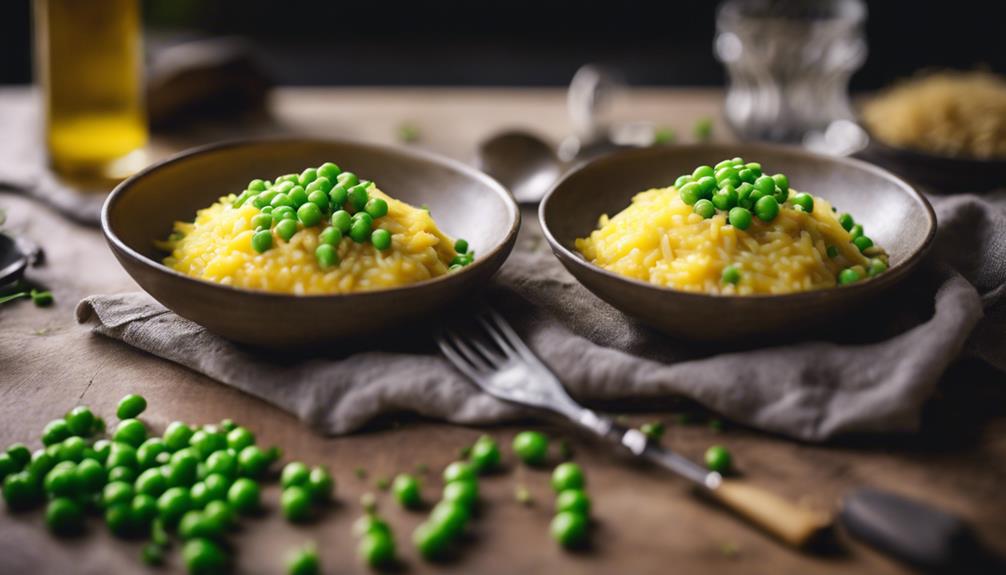
Craving a creamy and comforting dish with a touch of Italian flair? Let's talk risottos!
Get ready to explore classic varieties, masterful tips for achieving the perfect texture, and creative garnish ideas to elevate your risotto game to the next level.
Classic Risotto Varieties
Among the delectable Italian risottos to savor, classic varieties such as Risotto alla Milanese and Risotto ai Funghi stand out for their rich flavors and traditional preparation methods. Risotto is a beloved Northern Italian dish made with Arborio rice, prized for its creamy consistency.
When exploring the world of risotto, consider these classic varieties:
- Risotto alla Milanese: This vibrant dish features saffron, giving it a gorgeous color and a unique flavor that pairs perfectly with creamy Arborio rice.
- Risotto ai Funghi: A classic mushroom risotto that highlights the earthy and savory notes of porcini or wild mushrooms, creating a comforting and flavorful dish.
- Northern Italian Tradition: Both these risottos hail from the northern regions of Italy, showcasing the culinary traditions and flavors of the area.
- Primo Course: Risotto is often served as a primo, setting the stage for a delightful Italian meal to follow.
Tips for Perfect Risotto
For perfect risotto, make sure you use Arborio rice and master the art of constant stirring while slowly incorporating broth to achieve the desired creamy texture. Arborio rice, with its high starch content, is essential for creating that signature creaminess in your risotto.
The key to a successful risotto lies in the technique of stirring continuously to help release the starch gradually, resulting in a velvety texture. Remember, patience is key when adding broth – pour it in slowly, allowing the rice to absorb the liquid before adding more.
Risotto is often served as a primo in Italian meals, showcasing its importance and versatility. While traditional Risotto alla Milanese features saffron for a rich golden hue, feel free to experiment with various ingredients like mushrooms or seafood to create unique flavor profiles.
Whether you're a risotto aficionado or a beginner, mastering the art of stirring and incorporating broth will elevate your risotto game to new heights.
Risotto Garnish Ideas
Enhance the presentation and flavor of your Italian risottos with these delectable garnish ideas:
- Gremolata:
Add a burst of freshness by sprinkling a zesty mixture of lemon zest, garlic, and parsley over your creamy risotto.
- Crispy Pancetta:
For a savory and crunchy twist, consider topping your risotto with crispy pancetta or prosciutto to create a delightful contrast in texture.
- Truffle Oil:
Elevate your risotto to a luxurious level with a drizzle of truffle oil or shaved truffles, infusing the dish with a rich and earthy flavor profile.
- Fresh Herbs:
Enhance both the aroma and visual appeal of your risotto by garnishing it with fragrant fresh herbs like basil, thyme, or chives, adding a pop of color and freshness to each bite.
Experiment with these garnish ideas to take your Italian risottos to the next level, impressing your taste buds with a symphony of flavors and textures that will make every bite a delightful experience.
Succulent Meat Specialties
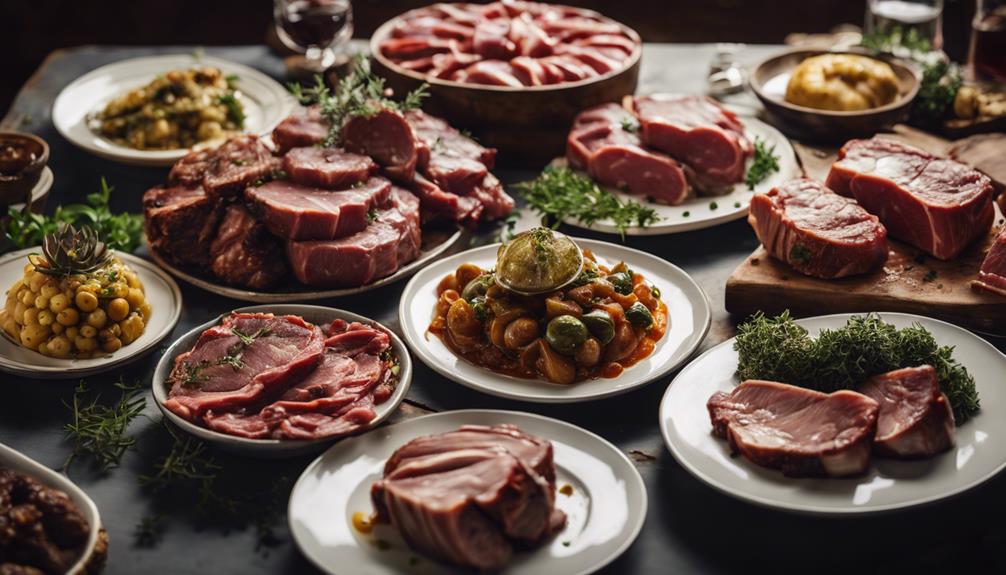
Indulge in the savory delights of Italian cuisine with succulent meat specialties that will tantalize your taste buds.
From the tender veal shanks of Osso Buco to the flavorful meat sauce of Pork Ragù Over Creamy Polenta, Italian meat dishes are sure to satisfy your cravings.
Braciole, a classic favorite, offers a delicious blend of beef, breadcrumbs, cheese, and herbs rolled into a mouth-watering dish.
If you're looking for a zesty kick, try the traditional Chicken Scarpariello, where chicken is cooked to perfection with vinegar, peppers, and aromatic herbs.
For a taste of Piedmont, savor the rich flavors and tender meat of Stracotto di Fassona Piemontese, a braised beef specialty that will leave you wanting more.
Italian succulent meat specialties bring together a symphony of flavors that showcase the culinary artistry of Italy.
Bon appétit!
Seafood Delicacies
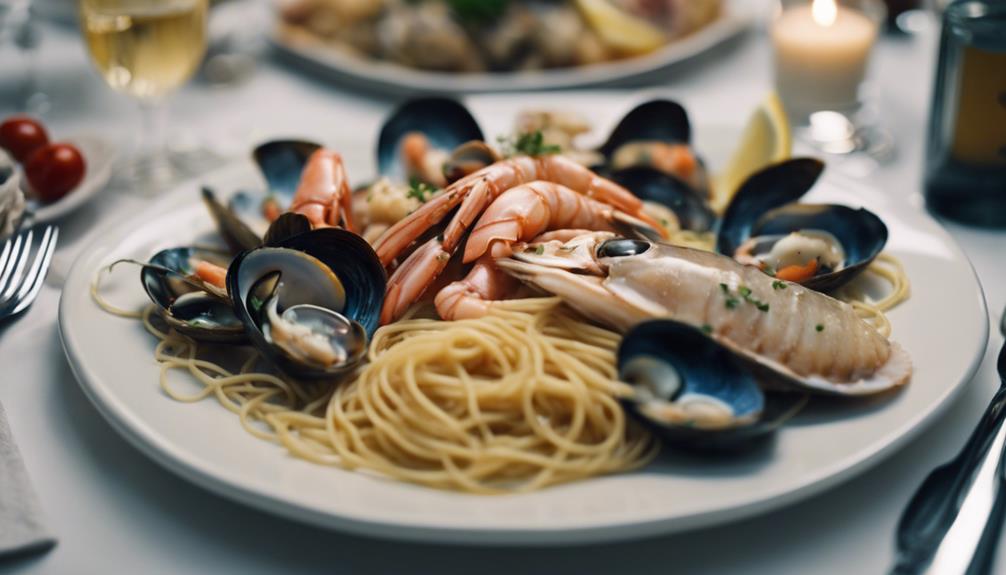
Explore the enticing world of Italian seafood delicacies that capture the essence of the country's coastal flavors and culinary heritage. Italian cuisine boasts a rich array of seafood dishes, each offering a unique blend of flavors and textures that will transport you to the shores of Italy. Immerse yourself in the Mediterranean-inspired culinary traditions with these tantalizing seafood delicacies:
- Cioppino: This delightful Italian seafood stew hails from San Francisco and is a medley of clams, mussels, shrimp, and fish, simmered in a savory broth that will warm your soul.
- Swordfish Sicilian-Style: Indulge in the flavors of Sicily with this traditional dish featuring succulent swordfish marinated in a zesty sauce of olive oil, lemon, garlic, and herbs.
- Cavatelli with Mussels: Savor the taste of the sea with this pasta dish that combines homemade cavatelli pasta, fresh mussels, Lillet, and aromatic dill for a burst of Mediterranean flavors.
- Italian Seafood Cuisine: With dishes like Cioppino, Swordfish Sicilian-Style, and Cavatelli with Mussels, Italian cuisine showcases the bounty of the sea and the culinary mastery of its people.
Assorted Italian Cheeses
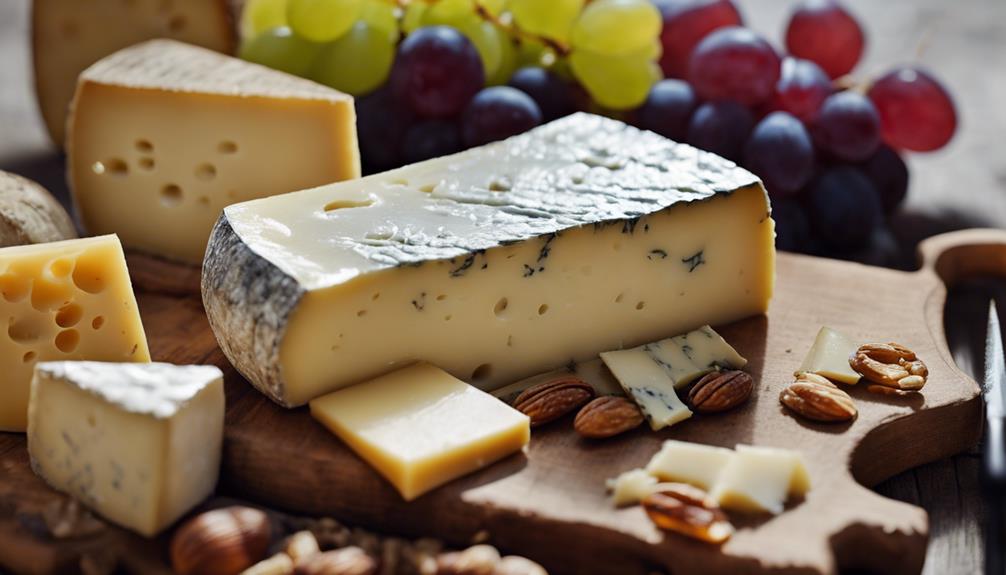
Italian cheeses, known as 'i formaggi,' play a significant role in showcasing the diverse culinary heritage of Italy. Parmigiano Reggiano and Mozzarella are just a couple of the popular varieties that have gained international fame. Italy's cheese-making tradition is deeply rooted, resulting in a vast array of artisanal cheeses that vary in texture, flavor, and aroma.
These cheeses aren't merely ingredients; they're a symbol of national pride and excellence.
From the sharp and salty Parmigiano Reggiano to the creamy and versatile Mozzarella, Italian cheeses are a staple in traditional dishes like pasta, risotto, and antipasti. The quality and diversity of these cheeses reflect Italy's rich culinary heritage and regional specialties.
Whether you're savoring a slice of aged Pecorino Romano or melting gooey Fontina on a panini, each cheese tells a story of craftsmanship and tradition that has been passed down through generations.
Irresistible Italian Gelato

Let's now shift our focus to the delectable world of irresistible Italian Gelato, a beloved dessert that captures the essence of Italy's culinary artistry.
- Creamy Texture: Italian gelato is renowned for its rich and creamy texture, achieved through a slower churning process that sets it apart from traditional ice cream. Each spoonful is a velvety delight that melts in your mouth, leaving a lingering sweetness.
- Flavors Galore: From classic pistachio to indulgent stracciatella and decadent hazelnut, Italian gelato offers a plethora of flavors to tantalize your taste buds. Whether you prefer fruity or nutty, there's a gelato flavor for everyone to savor.
- Traditional Dessert: Gelato is more than just a frozen treat; it's a symbol of Italy's culinary heritage. Found in gelato shops scattered across the country, this traditional dessert is a staple in Italian cuisine, beloved by both locals and tourists.
- Churning Magic: The magic of gelato lies in its churning process, which creates a denser and smoother consistency compared to regular ice cream. This meticulous technique enhances the overall experience, making every scoop a moment of pure bliss.
Frequently Asked Questions
What Are the Top 10 Italian Dishes?
You can explore the top 10 Italian dishes, from pizza to tiramisu, offering diverse flavors and textures. Each dish showcases Italy's culinary heritage with fresh ingredients and regional influences, inviting you to savor the gastronomic tapestry.
What Are 5 Traditional Italian Dishes?
You're curious about 5 traditional Italian dishes? Explore the delicious world of Pasta Carbonara, Osso Buco, Lasagne, Risotto alla Milanese, and Caprese Salad. Each bite tells a flavorful story from different regions of Italy. Enjoy exploring!
What Are Italian Main Dishes?
Italian main dishes range from pasta classics like Spaghetti Bolognese and Fettuccine Alfredo to hearty meat options such as Osso Buco and Saltimbocca. Seafood lovers enjoy Cioppino and Swordfish Sicilian-Style. Regional specialties like Florentine Butter Chicken also shine.
What Is Italy's Most Popular Dishes?
When exploring Italy's most popular dishes, you'll find pizza, pasta, risotto, arancini, and gelato. Each dish offers a unique taste of Italian culinary excellence, showcasing a blend of flavors, textures, and regional influences.
Which Unique Italian Dishes Can Be Found on the Oliva Italian Mediterranean Cuisine Menu?
The Oliva Italian Mediterranean Cuisine Menu features a variety of unique Italian dishes, including their famous Aglio e Olio pasta, Caprese salad, and Osso Buco. Each dish on the Oliva Italian Mediterranean Cuisine Menu is made with authentic Italian ingredients and prepared with traditional Mediterranean cooking techniques.
Conclusion
To sum up, Italian cuisine offers a wide array of delicious dishes that are sure to satisfy any food lover. From mouth-watering pizzas to creamy gelato, there's something for everyone to enjoy.
So why not indulge in the flavors of Italy and experience a culinary journey like no other? Buon appetito!
